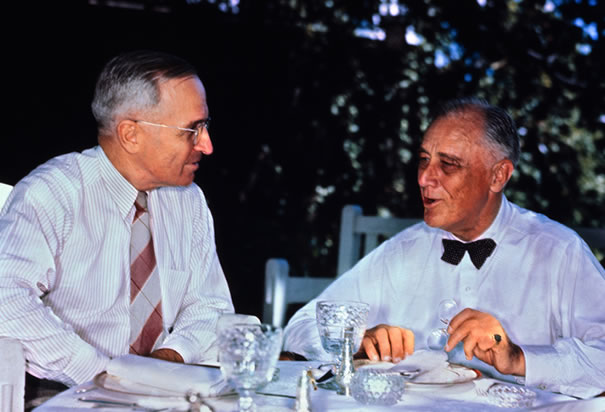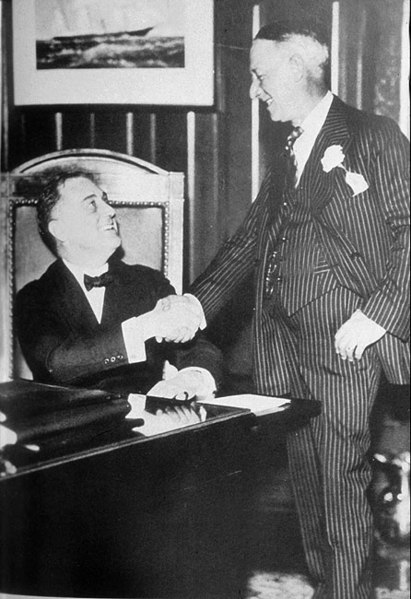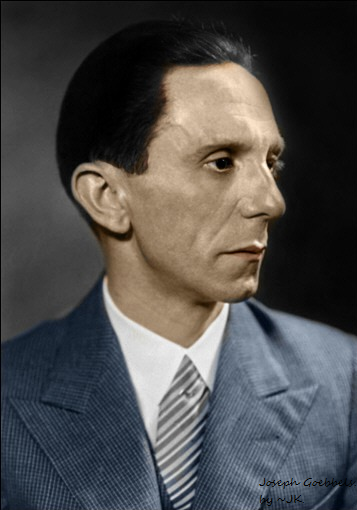You are using an out of date browser. It may not display this or other websites correctly.
You should upgrade or use an alternative browser.
You should upgrade or use an alternative browser.
Photos from Featherston's Confederacy/ TL-191
- Thread starter Alternatehistoryguy47
- Start date
-
- Tags
- the rising sun
The USS Kansas under way in the Caribbean, in the background you can see the shores of Hispaniola. The Kansas was the sister ship to the Oregon. Both operated in the Caribbean and the gulf during the Second Great war. The Kansas is well known for assisting in the hunt for CSS South Carolina, the last battleship of the Confederate navy. The Kansas is now a museum ship in San Francisco. This photograph was taken in 1943.
Last edited:

Vice-President Truman and Assistant Secretary of War Franklin Roosevelt, discussing the future of the occupied Southern States.
Last edited:

President Al Smith shaking hands with Assistant Secretary of War Franklin Roosevelt, the latter congratulating the former for winning reelection in 1940.
The destroyer USS Pembroke on her way to Boston for decommissioning in July, 1963. The Pembroke is best known for delivering the killing blow to the CSS South Carolina in the last major naval engagement in the Second Great War. She is now a museum ship in Beaufort, South Carolina. She was originally a museum in Boston, but when South Carolina was readmitted to the Union, she was moved there as a sign of goodwill. She is the only surviving Ericsson class destroyer left in existence. A notable fact about the Pembroke is the fact that she never lost a single crewman in combat.
Last edited:
The destroyer USS Poole under way off the Florida coast after the Second Great War, circa 1944. The Poole was an Ericsson class destroyer, and had a distinguished service in the South Atlantic. She was sunk by an exploding boat while on blockade duty off of Miami in early 1945. Her wreck is now a protected war memorial.
Last edited:

Socialist President Barack Obama shaking hands with Sandwich Islands Governor and Mormon Church leader Mitt Romney after the Church's return to recognition as a religion under the Constitution.
Analog to an article in the International section of New York Times I read today.
Pittsburgh Journal
After 75 Years, America Recalls Pittsburgh Battle
PITTSBURGH, Pa. - Like every American schoolchild, I grew up learning about Featherston's rapid advance through Ohio and Pennsylvania during the Second Great War, and how it was halted at the Battle of Pittsburgh - a crucial turning point in the war.
The fight raged for 200 days, and the city was reduced to ruins. Civilians who couldn't evacuate starved, some eating rats and clay. Resistance to the Confederate onslaught was fierce as the defending army had no choice but to fend off the attack or die standing, as not only would the United States lose a critical manufacturing center, but the road to Philadelphia would be wide open. At the end, a population that had been around 700,000 was just 35,000.
Since the war, the city has been completely rebuilt, and has often been given the nickname of Unionville, as it was the site of the defining battle of a war that ultimately reunited a nation. But memories of the fighting, 75 years ago this year, are strong. Pittsburghers walking the streets or going to work pass by many kinds of memorials to those who sacrificed their lives. The most pivotal memorial is the Pittsburgh Remembrance Statue in Remembrance Square, unveiled for the 50th anniversary of the pivotal battle in 1992. Inside the statue at the base of it are the names of all those accounted for who died defending the city. There was talk of including the Confederates who died but was opposed as they died trying to destroy the city and the US. Visible from many vantage points in the city, the statue is a reminder of the price that the American people paid to defeat Freedomism.
I've workd as a conflict photographer for more than ten years. Once when visiting Homs, Ottoman Empire, I found myself comparing the destruction I saw with that of Pittsburgh. When I visit Pittsburgh now -modern, reconstructed- I wonder if Homs and other cities destroyed by war will ever look and feel like this.
When the Confederates sent in Barrels, Michael Parker was fighting in a trench. He had already thrown his grenades and had just two Featherston Fizzes left. He was raising one bottle to throw when a bullet smashed it, setting it on fire. He took the remaining bottle, jumped out of the trench and hit the nearest Confederate barrel, setting it on fire. The other barrels withdrew.
After the fighting, all that remained of the town of Etna, just north of Pittsburgh, were ruins of buildings, ashes, shell craters, and thousands of corpses. Today, two cemeteries stand at the site; 60,000 Confederate soldiers are buried in one, 20,000 US fighters in the other.
Each summer, groups of volunteers look for the remains of soldiers in fields and under city streets. This year, the bodies of 800 soldiers were discovered. One day this summer, searchers unearthed the body of an American soldier at the bottom of a pit a meter deep, his arms folded and legs bent.
During the war, the industrial part of the city was a station for tractors and barrels. Now, each summer, an orchestra plays popular songs from the prewar era.
"I was about 5 years old when the Confederates began to bomb Pittsburgh," recalled Anthony Barnes, who is 80-something and was dancing with his wife, Ida. "I was playing in the street when the rumble of planes and explosions began."
Benjamin Gates, 97, is a war veteran. He said that every day, his battalion had forced back barrel offensives, the bombs from Confederate air raids falling from the sky. On Sept. 12, 1942, his battalion was almost completely surrounded. But he refused to leave his wounded friend, fighting off the advancing forces with his machine gun. There was a huge explosion. His head spun and his eyes saw stars. He woke up in a hospital.
The battle created so many scars in this city that may never be totally healed. The Wall of Heroes, also part of the Memorial, contains a section dedicated to a nurse carrying a wounded soldiers from the battlefield.
The Allegheny River was Featherston's main target. US soldiers fought to the last man to keep possession of this strategic artery and important symbol. Now the calm, gentle surface of the river hides traces of the bloody fight. At the bottom of the riverbed, burned-out ships, barrels, and the remains of thousands of soldiers still rest.
Pittsburgh Journal
After 75 Years, America Recalls Pittsburgh Battle
PITTSBURGH, Pa. - Like every American schoolchild, I grew up learning about Featherston's rapid advance through Ohio and Pennsylvania during the Second Great War, and how it was halted at the Battle of Pittsburgh - a crucial turning point in the war.
The fight raged for 200 days, and the city was reduced to ruins. Civilians who couldn't evacuate starved, some eating rats and clay. Resistance to the Confederate onslaught was fierce as the defending army had no choice but to fend off the attack or die standing, as not only would the United States lose a critical manufacturing center, but the road to Philadelphia would be wide open. At the end, a population that had been around 700,000 was just 35,000.
Since the war, the city has been completely rebuilt, and has often been given the nickname of Unionville, as it was the site of the defining battle of a war that ultimately reunited a nation. But memories of the fighting, 75 years ago this year, are strong. Pittsburghers walking the streets or going to work pass by many kinds of memorials to those who sacrificed their lives. The most pivotal memorial is the Pittsburgh Remembrance Statue in Remembrance Square, unveiled for the 50th anniversary of the pivotal battle in 1992. Inside the statue at the base of it are the names of all those accounted for who died defending the city. There was talk of including the Confederates who died but was opposed as they died trying to destroy the city and the US. Visible from many vantage points in the city, the statue is a reminder of the price that the American people paid to defeat Freedomism.
I've workd as a conflict photographer for more than ten years. Once when visiting Homs, Ottoman Empire, I found myself comparing the destruction I saw with that of Pittsburgh. When I visit Pittsburgh now -modern, reconstructed- I wonder if Homs and other cities destroyed by war will ever look and feel like this.
When the Confederates sent in Barrels, Michael Parker was fighting in a trench. He had already thrown his grenades and had just two Featherston Fizzes left. He was raising one bottle to throw when a bullet smashed it, setting it on fire. He took the remaining bottle, jumped out of the trench and hit the nearest Confederate barrel, setting it on fire. The other barrels withdrew.
After the fighting, all that remained of the town of Etna, just north of Pittsburgh, were ruins of buildings, ashes, shell craters, and thousands of corpses. Today, two cemeteries stand at the site; 60,000 Confederate soldiers are buried in one, 20,000 US fighters in the other.
Each summer, groups of volunteers look for the remains of soldiers in fields and under city streets. This year, the bodies of 800 soldiers were discovered. One day this summer, searchers unearthed the body of an American soldier at the bottom of a pit a meter deep, his arms folded and legs bent.
During the war, the industrial part of the city was a station for tractors and barrels. Now, each summer, an orchestra plays popular songs from the prewar era.
"I was about 5 years old when the Confederates began to bomb Pittsburgh," recalled Anthony Barnes, who is 80-something and was dancing with his wife, Ida. "I was playing in the street when the rumble of planes and explosions began."
Benjamin Gates, 97, is a war veteran. He said that every day, his battalion had forced back barrel offensives, the bombs from Confederate air raids falling from the sky. On Sept. 12, 1942, his battalion was almost completely surrounded. But he refused to leave his wounded friend, fighting off the advancing forces with his machine gun. There was a huge explosion. His head spun and his eyes saw stars. He woke up in a hospital.
The battle created so many scars in this city that may never be totally healed. The Wall of Heroes, also part of the Memorial, contains a section dedicated to a nurse carrying a wounded soldiers from the battlefield.
The Allegheny River was Featherston's main target. US soldiers fought to the last man to keep possession of this strategic artery and important symbol. Now the calm, gentle surface of the river hides traces of the bloody fight. At the bottom of the riverbed, burned-out ships, barrels, and the remains of thousands of soldiers still rest.
I think you’re referring to the advance into the Carolinas. The march to the sea was complete by then.View attachment 355333
The town of Hardeeville, SC, circa 1938. Nowadays, there is nothing left but ruins in what was once a bustling little town, a casualty of the rapid advances of General Morrell's drive to the sea.
Yes. It's in Jasper County, South Carolina.That's the town, that Chester Martin's platoon destroyed, wasn't it?

US Marines during the Japaese Invasion of the Samoa Islands, July 1964, the opening days of the Fourth Pacific War
Share:
